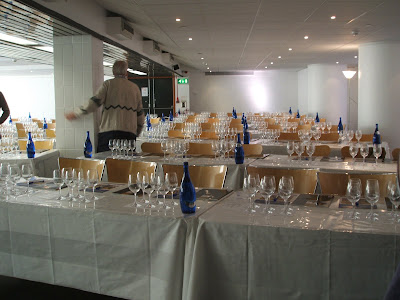I went to Barbican Centre to judge sake for IWC.
There is also wine judges and they spent a week to judge all of those wines (picture below). It was just 16 judges to taste sake in 2007, and 24 judges to try sake in 2010.
The groups were divided in 4 and each group had both Japanese and non Japanese judges, 50-50, this is very important to discuss in group with different palate or even back ground.
今日は何とも忙しく、長い一日でした。
本日、IWCの酒部門の審査員の一人として、バービカンセンターへ行きました。
ワインの審査も、先週から約一週間程かけて行われました(写真下)
2007年には16人で執り行われていた審査も、今年は24人にまで膨らみ、今日は、4つのグループに分かれました。
各グループには日本人と日本人以外の審査員の半々で構成され、日本人からみた酒の味、日本人以外の思う美味しいという日本酒を発掘し、それをグループでディスカッションしました。これは、とっても大切な事なのです。

Below is the sake. (I've taken this picture after we've finished...)
About 400 sake were imported from Japan for this competition today.
こちらが本日の日本酒です(審査が終わってから撮りました、ご心配なく)
今年は約400種の日本酒が揃えられました。
Our group was very quick, didn't argue at all (sometimes it happens...) and we've tasted 133 sake. However we could find only few sake that we thought were "good". It was a very tough day.
私たちのグループでは、言い合いにもならず(よくあるんです…)、淡々とテイスティングをし、 一番早く進んだグループだったと思います。その介があって私達は、133種の日本酒をテイスティングしました。しかしながら、”おお、これは旨い!” という酒には思った程出会えませんでした。
私たちのグループでは、言い合いにもならず(よくあるんです…)、淡々とテイスティングをし、 一番早く進んだグループだったと思います。その介があって私達は、133種の日本酒をテイスティングしました。しかしながら、”おお、これは旨い!” という酒には思った程出会えませんでした。
The subject was Junmai vs Non- Junmai.
We've tried Karakuchi Masuizumi and Junmai Masuizumi from Masuda Shuzo, Aji Ginjo Urakasumi and Zen Junmai Ginjo Urakasumi from Saura Co., Ltd and Daiginjo Limited and Junmai Daiginjo from Masuda Shuzo.
I could find differences between Junmai and non-Junmai easily, even it was a blind tasting.
For anybody who doesn't know about categories of sake... I'll explain next time more, but basically some sake are made with rice, water, yeast, Koji (also long story to talk about this...) and distilled alcohol. This alcohol brings crisp, aromatic or dry characteristics into sake. This sake could be categorise as non-Junmai or HONJOZO in Japanese.
And if there is no distilled alcohol added, these kind of sake is called JUNMAI style.
I can pick alcohol both on the nose and palate most of the times. And some sake, you can even tell from the texture or structure of aroma.
審査の後は、別室に移動し、大橋さんによる日本酒のレクチャーがありました。
課題は、純米 対 本醸造。
私達は、満寿泉の辛口満寿泉と、純米満寿泉、浦霞の味吟醸 浦霞と禅 純米吟醸、満寿泉からは限定大吟醸 満寿泉、純米大吟醸をそれぞれ飲み比べました。
万が一純米と本醸造の違いが解らないという方に…、次回もっと詳しく説明しますが、
用は、世界に存在する日本酒の何種かは、米、水、麹(今回は説明しません、あしからず)、酵母、醸造アルコールで作られます。この醸造アルコールは酒に辛口な個性を出したり香り高くなったりという不思議な力があるのです。この、醸造アルコールを含有した日本酒に付けられたカテゴリーが、”本醸造”となる訳です。そして、このアルコールが全く使用されていない日本酒を”純米”と言います。
This is Mr Ohashi.
こちらが大橋さんです。
The lecture was packed. I could see so many peoples had so many questions but not all were answered.
I realised there is so many things WE (sake sommelier and anybody involved in sake) can do. Sake has a lots of potential, hence we need more sake ambassador.
I want to always help as many people and sake consumer as possible if they want to learn.
Now, I am very proud I have a great culture on my back ground and what I am doing in London, even nobody recognise who I am and what I am doing.
酒マスタークラスは満員御礼で、何とも大成功に終わりました。
少し、時間に余裕がなかったのもありますが、特に日本人以外の参加者からは、たくさん質問があり、終わってからももっと知りたいという人が大橋さんに押し掛けました。
本日見てみて、4、5年前と比べて何が変わっているか? 日本酒が浸透して、参加者の質問の内容が変わっているか。考えてはみましたが、実際の所ほとんど変わりはなく、私たち(利き酒師や、日本酒に関わっている関係者全て)に、まだまだやれる事はたくさんあると実感しました。日本酒に潜む可能性はまだ多く、先駆者がもっともっといろいろな分野で必要である事も思い知らされました。
私は、これからも日本酒を愛し、学びたいという声があればいつでもその手伝いをしていきたいと思います。
また、”日本の酒”という素晴らしい文化と、私が今ロンドンでその酒に関わっている事を思うととても誇りに思えるのです。
それがたとえ、誰の目にも止まらなくても。








No comments:
Post a Comment